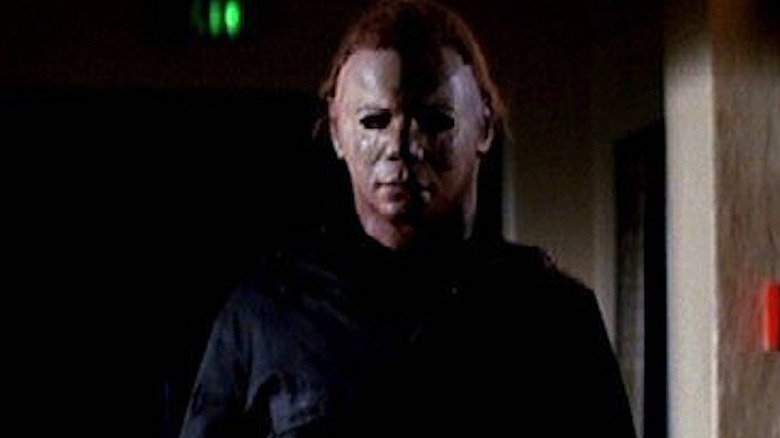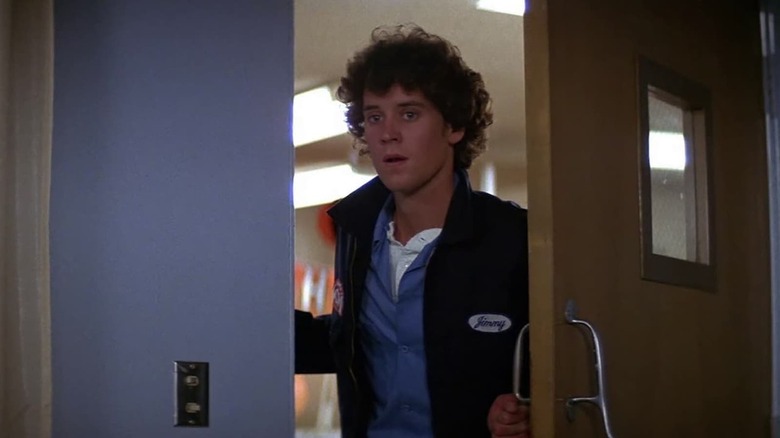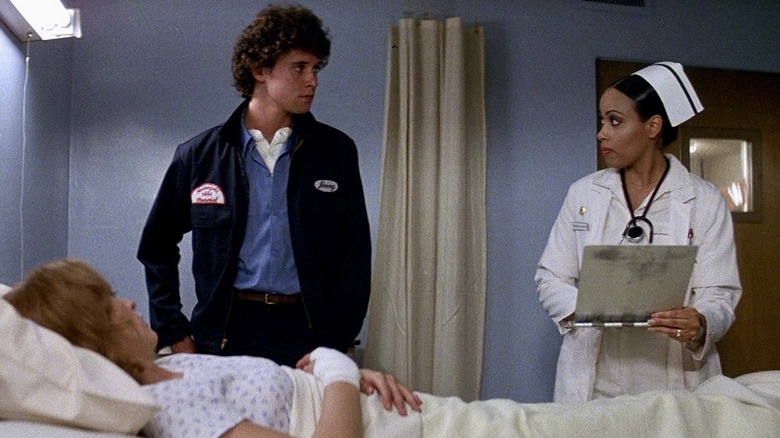Halloween 2 Completely Changed One Character's Fate For The TV Edit
John Carpenter's "Halloween" is one of the finest horror films ever made. Rick Rosenthal's "Halloween II" is one or 12 steps down from that.
Carpenter's original is also one of the most successful independent productions of all time. It launched the slasher film craze, made Jamie Lee Curtis a star and, thanks to the white-masked Michael Myers, spawned lifelong nightmares in the subconscious of every kid who begged their parents to let them watch it. Forty-five years on, "Halloween" is still a wildly effective, brilliantly crafted film. It is, per its tagline, "The Night He Came Home." "Halloween II" was unimaginatively sold as "More of the Night He Came Home." It's basically the "More American Graffiti" of horror flicks, and, like that film, it's better than its reputation suggests.
Having established himself as a genre auteur, Carpenter bowed out of directing the sequel and set his sights on "The Fog." He did, however, want the check producer Dino De Laurentiis was going to cut for the follow-up, so he banged out the script with his creative partner Debra Hill while knocking back beers, and wound up with something halfway filmable. Looking back on the project years later, Carpenter recalled the process as a haphazard affair.
"Halloween II" is nothing more than a scare machine, but it's a fun, hospital-set, cat-and-mouse contraption that gives Curtis' Laurie Strode a degree of agency, despite her drugged-up state (she's administered a sedative early on, so that, in a rare case for a slasher movie, you have a rock-solid explanation for why she can't outrun her slow-gaited predator). "Halloween II" also gives Laurie a kinda-sorta love interest in Lance Guest's kindly paramedic Jimmy. And while his fate is unresolved in the theatrical cut of the movie, the TV edit gives us an unexpectedly upbeat resolution for a guy who'd be dead meat in a typical slasher.
The trials of Jimmy
In the theatrical cut of "Halloween II," Jimmy slips on a puddle of blood in a hospital room and slams his head on the floor, thus concussing himself. For the rest of the film, he stumbles around in a daze trying to regain his senses. His final act is to wander out of the hospital, get in a car and pass out on the steering wheel, which sets off the car horn (and that sucks for the equally addled Laurie, given that she's hiding out in the parking lot). Did Michael take a brief break from his pursuit of Laurie to finish off poor Jimmy? The movie leaves us hanging.
When "Halloween II" was recut for television — which, due to the film's R-rated gruesomeness (a marked departure from the original's lack of gore), likely necessitated some padding out of the runtime — Jimmy gets one last scene in an ambulance with Laurie. He takes her hand and says, "We made it."
Whither Jimmy?
How far did they make it? In Dwight H. Little's "Halloween 4: The Return of Michael Myers," we're introduced to Danielle Harris' Jamie Lloyd, the orphaned daughter of Laurie and an unnamed father. Was that Jimmy? And did he also perish in the off-screen car wreck that claimed Laurie's life?
That sequel timeline slammed into a wall with Joe Chappelle's "Halloween: The Curse of Michael Myers" in 1995. As for David Gordon Green's retconned "Halloween" trilogy, which began in 2018, Jimmy never made an appearance. He's probably the most ill-served character in the "Halloween" universe: a nice Emergency Medical Technician whose life gets torn asunder by knocking himself silly on a hospital room floor.
It might've been a thankless role, but Lance Guest made enough of an impression as Jimmy to land the lead in the 1984 space adventure "The Last Starfighter," which, coincidentally, was directed by Nick Castle, the once-and-future Michael Myers. If you can't beat The Shape, you might as well work with him.


